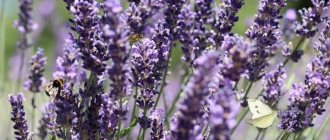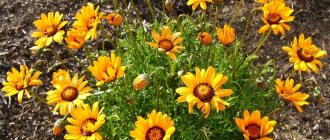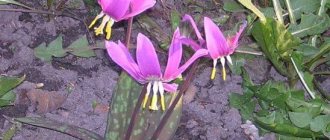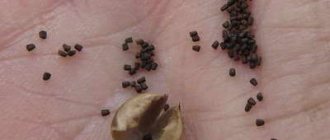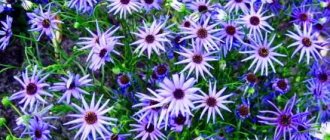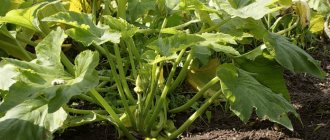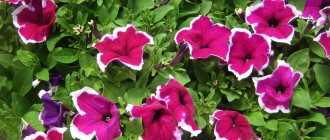Coriander, or cilantro - description of the plant
Many people are mistaken in believing that coriander and cilantro are different plants. In reality, they are just different parts of the same crop: cilantro is a green, and coriander is a seed. Perhaps the difference in names comes from the fact that these components have different tastes and aroma. In general, the plant is most often called coriander. Although in different areas you can find other names: Chinese parsley, Mexican parsley, calandra, shlondra, kinji, chilantro, etc. In appearance, coriander is similar to ordinary parsley, but it has a specific taste.
The leaves of parsley and coriander are similar in shape: on the left are coriander greens, on the right are parsley
There are many versions of the origin of the name of the plant. Folk etymology derives it from the ancient Greek κόρις, which means “bug”. Indeed, the greenery has a pungent aroma, somewhat reminiscent of the smell of a bug, due to the high content of a special substance (decylaldehyde) in the essential oil of the plant’s leaves. During the drying process, this smell disappears almost completely; ripened seeds contain only its remnants.
A little history
The supposed homeland of the culture is the eastern coast of the Mediterranean Sea. According to historical information, coriander appeared in Europe even before our era during the Roman conquests. For example, in the south-eastern counties of Great Britain it is still common as a weed. During the era of great geographical discoveries, Europeans brought culture to the American continent, as well as to Australia and New Zealand.
In Russia, coriander was first mentioned in the 18th century, and the beginning of mass cultivation of the crop is associated with the name of Count P.I. Apraksin, who brought the seeds of the plant from Spain and ordered the peasants of the village of Krasnoye, Voronezh province, to grow the crop.
Now coriander is cultivated everywhere, not only on personal plots, but also on an industrial scale.
In many regions, coriander is cultivated to obtain essential oil; in addition, the plant is an excellent honey plant.
Description and main characteristics
Coriander is an annual herbaceous plant belonging to the Umbelliferae family:
- simple and pinnately dissected leaves grow on an erect stem with a branched upper part;
- plant height ranges from 40–70 cm;
- The culture blooms in June - July with small white or pinkish flowers collected in inflorescences;
- by the end of summer, in place of the flowers, seed umbels with spherical hard seeds with sinuous or straight ribs are formed;
- Fruits ripen by mid-September in northern latitudes, and in the south - about a month earlier.
Photo gallery: greens, flowers and coriander seeds
Coriander fruits are small, hard, ribbed balls.
Coriander flowers are arranged in the form of umbrellas at the ends of the flower stalks
Cilantro has unequal leaves along the stem: the lower ones have petioles, and the upper leaves sit directly on the stem, the latter have a slightly elongated shape
Application, benefits and harm of coriander
The leaves, seeds and roots of coriander are used in cooking. Dried and crushed seeds are usually added to confectionery products, cheeses and sausages, and used in the preparation of meat and fish dishes and soups. This unique plant gives a special taste not only to food, but also to drinks. The spice, for example, is included in the recipe for the well-known Borodinskaya tincture and in the original Macedonian liqueur.
There is no point in storing ground plant seeds, since the powder quickly loses its taste and aroma. It is better to harvest whole seeds. Before use, they are lightly fried in a dry frying pan and only then crushed.
Coriander seeds will not lose their flavor if crushed before use.
Cilantro - the greenery of the plant - is not recommended to be cooked. It is added to various dishes, including salads. Ground coriander roots have a more muted flavor than green leaves. Most often they are used in sauces for meat and fish dishes. The flavor of the root goes well with garlic, peanut butter and pepper.
Coriander oil and extract are widely used in cosmetology. They are included in various creams, tonics, lotions for skin and hair care. Interestingly, in addition to the anti-inflammatory, whitening and rejuvenating effect, a weak concentration of coriander oil can give products the aroma of a rose or lily of the valley. Coriander oil is popular in aromatherapy and soap making.
Concentrated coriander oil has a yellowish color, a pungent odor and a bitter taste.
The wide use of the plant, including in pharmacology, is explained by its unique chemical composition: high content of dietary fiber, organic acids, starch, vitamins, macro- and microelements. Coriander is capable of:
- relieve spasmodic pain;
- improve digestion, relieve heaviness in the stomach after heavy meals;
- suppress the development of malignant tumors;
- maintain eye health;
- stop bleeding;
- remove toxins from the body;
- fight infections and germs.
Coriander seeds and greens should not be consumed by people with individual intolerance to the plant, with circulatory problems, as well as with diabetes and hypertension.
Features of cilantro cultivation.
To grow a crop and get a high-quality harvest, four important conditions must be met.
- When preparing the land for planting coriander, you need to add additional compost .
- On hot days, plants need to be provided not only with constant watering, but also not allow the soil to dry out, as this will slow down the maturation of seedlings. As a result, you may not have time to get the harvest before the onset of cold weather.
- You should not grow coriander and cilantro from the same plants. It is advisable to separate them: collect seeds from some, fragrant greens from others.
- Completing all agrotechnical measures will make it possible to obtain a seed harvest in mid-September.
Varieties and types of coriander
Before you start planting coriander on your site, you need to decide for what purpose you plan to grow the plant, and, depending on this, select the appropriate variety. When choosing, you should pay attention to the timing of ripening, the yield of greens and fruits, aromatic qualities, and the richness of the color of leaves and seeds. The State Register of Breeding Achievements approved for use on the territory of the Russian Federation includes 13 varieties of this plant. Three of them (Medun, Mius and Ranniy) are recommended for cultivation in the North Caucasus region, the rest have no restrictions on the growing area.
Table: coriander varieties included in the State Register of Breeding Achievements
| Variety name | Growing season, days | Description | Seed yield g/m2 | Peculiarities |
| Chord | 109 |
| about 100 |
|
| Alekseevsky 190 | 89–91 |
| about 150 |
|
| Alekseevsky 413 | from 66 |
| from 120 |
|
| Aroma | 109 |
| from 60 |
|
| Medun | N/A | Compact plant with an erect stem up to 115 cm high | about 220 |
|
| Mius | N/A |
| from 110 | Drought resistant |
| Nectar | 30–40 | Branched bush up to 90 cm high | N/A |
|
| Early | 30–50 | A highly branched plant about half a meter high with large dark green leaves and a persistent, strong, spicy aroma | about 150 |
|
| Light | 100–110 |
| from 100 | Weakly affected by ramulariasis |
| Strongman | 251 |
| from 220 |
|
| Eva | 35–45 | Semi-closed bush about 60 cm high with a stem of medium thickness | about 140 |
|
| Gialos | 107 |
| from 130 |
|
| Amber | 40–45 | Compact bush, about 50 cm high | about 150 |
|
Photo gallery: domestically selected coriander varieties
Coriander Alekseevsky 190 is grown directly to obtain a harvest of mature seeds
Coriander of the Yantar variety is distinguished by good foliage, slow bolting, and high aromaticity
The main qualities of the Medun variety are resistance to ramularia, increased winter hardiness, and the ability to grow during winter and spring sowing periods.
Coriander Mius - variety for spring sowing
Nectar is a variety suitable for winter and spring sowing periods
Coriander variety Early is a fast-growing leaf variety.
Coriander Light is a mid-season variety with juicy leaves of increased aromaticity
General information
Cilantro is grown everywhere. This spicy herb is used freshly picked and dried as an addition to a huge range of dishes and sauces, making the culinary product piquant in taste. Due to the high content of essential oils, cilantro has a very strong aroma, characteristic of seasonings. The seeds are also widely used in the culinary field.
Note. Coriander has good resistance to cold, which characterizes winter in mid-latitudes.
The Japanese people, who have been perfecting the process of planting cilantro for more than 5 thousand years, claim that consuming coriander has a positive effect on life expectancy. The spread of Korean national dishes has ensured the popularity of this herbaceous plant in our country.
The chemical composition of cilantro includes the following mineral elements:
- essential oils;
- potassium;
- calcium;
- phosphorus;
- iodine;
- vitamin A;
- vitamin E;
- vitamin K;
- vitamin B;
- vitamin P;
- vitamin PP.
Coriander
Cilantro, consumed fresh, helps increase appetite and accelerate the breakdown of heavy foods.
Ailments for which the leaf and seed parts of the plant are especially useful:
- decreased brain activity;
- deterioration of heart function;
- tendency to hysteria;
- depressed states.
There are a huge number of varietal varieties of coriander. Their difference lies in the specific purpose of growing the plant: for obtaining a seed crop, only one variety is presented, and for collecting greens, they are completely different from the first category, aimed at obtaining seeds. All of them, like other garden crops, are divided into early-ripening, mid-ripening and late-ripening varieties.
Growing coriander in open ground
Coriander is a cold-resistant plant. Its seedlings can withstand frosts down to –5 °C, so sowing can begin early, as soon as the soil thaws. Choose a sunny place for the culture. In a shaded area, it produces little greenery, quickly throws out flower stalks, and the fruits grow small and take a long time to ripen. An exception may be sparse shade from trees and shrubs. The ideal soil for coriander is slightly alkaline or neutral, nutritious, with good air and moisture permeability. During autumn digging, it is filled with organic matter and a potassium-phosphorus complex (40 g per 1 sq. m).
It is best to allocate a place for coriander where beets, corn or legumes grew last season.
Planting in a garden bed
Seeds can be used either your own or purchased. It should be borne in mind that they remain viable for 2–3 years. Seeds most often do not require soaking or pre-sowing preparation. Sowing coriander is completely standard:
- In the spring, the soil on the site is thoroughly loosened, and nitrogen fertilizers are applied if necessary.
- Make grooves in the garden bed at a distance of at least 20 cm from each other and spill them with water.
For 1 sq. m to obtain green cilantro, sow 2–2.5 g of seeds, and 1.5–2 g for seeds
- Seeds are sown sparsely, every 8–10 cm from each other. To ensure the quality of seedlings, you can put 2 seeds in one place and remove weaker seedlings during the growth process.
- The sowing depth is kept to about 1.5 cm. Although some gardeners advise planting deeper, assuring that in this case the plant is less susceptible to disease.
- After sowing the seeds, water the bed abundantly.
Seeds begin to germinate at soil temperatures of +6 °C. After 5–20 days, shoots will appear. Germination time depends on the variety, timing and storage conditions of seeds, and weather conditions.
Many varieties of coriander can be sown in autumn. In this case, the harvest is more abundant than when sowing in spring.
The fresher the seeds are, the stronger and more friendly shoots they will produce.
To constantly have fresh greens, the seeds are sown in stages every 2-3 weeks, starting in April and ending in mid-summer. Such sowing will allow the same area to be used for cultivation, provided that the greenery is cut before the bud-laying phase. Please note that when reusing soil, it must be fertilized with nitroammophos or superphosphate.
Coriander care
Caring for the crop is not at all difficult.
After 2–3 true leaves appear on the plant, the plantings are thinned out. The distance between growing seedlings must be at least 10 cm, otherwise the coriander will quickly bloom. Please note that removed plants are not replanted. Cilantro has poorly developed adventitious roots, so even slight damage to the central taproot will lead to the death of the seedlings.
A bed with coriander before thinning (photo on the left) and after (photo on the right)
To prevent cilantro from being choked by weeds and from sprouting peduncles due to lack of light, it is necessary to regularly and thoroughly weed the garden bed, as well as systematically and abundantly water it. With a lack of moisture, young plants can also begin to bloom. The amount of watering is reduced to a minimum only during the period of fruit ripening. After each watering, the row spacing must be loosened. If there is not enough air in the soil, the coriander will produce little greenery and quickly throw out its inflorescences.
During the period of active growth, feeding the crop is not recommended. All fertilizers must be applied in advance - during autumn and spring digging of the soil.
Harvesting greenery and preparing seeds
Cilantro is cut when the plants reach a height of 14–15 cm, and some of them can move from the stemming phase to the budding phase. It is better to clean it in the morning and make the cut near the ground. After cutting, coriander does not grow back.
Coriander greens should be collected before discarding the flower baskets.
Cut greens are washed and laid out or hung to dry in a dry and dark room. Drying in the light leads to the loss of many beneficial qualities of cilantro. If you plan to chop the herb, you should do this after it is completely dry, as cutting fresh cilantro will also result in the loss of beneficial essential oils.
After drying, it is recommended to store the spice in tightly closed containers.
If the coriander has bloomed, then its greenery becomes scarce, becomes rough and tough. In this case, it is better to leave the plant alone until the seeds ripen. In moderate climates, coriander sown in late April will bloom in July. The flowering period lasts about 40 days.
Ripe coriander seeds have a unique spicy smell, while the smell of green fruits is, to put it mildly, unpleasant
In September, most of the seeds should turn brown. At this time, the umbrellas are cut, tied into bundles and hung to dry. You need to spread a film or clean cloth under them for easy collection of crumbling seeds. After the color of all the seeds changes to brown, and the taste and aroma become characteristic of coriander, they are shaken out of the boxes and sifted, separating them from the remains of the herb. The collected seeds should be stored in glass containers with a lid.
Harvesting and harvesting
Finally, all the hassle with planting, watering, fertilizing and fighting against diseases and parasites has passed. And now the long-awaited time has come - harvesting.
It is best to do this before the cilantro begins to bloom - after which the leaves will acquire an unpleasant bitter taste. Therefore, it is advisable to cut off the inflorescences immediately after they appear.
The taste of the greens will become most intense when the bush stops growing, which means it’s time to harvest. It is advisable to do this in the morning, choosing a sunny day and waiting for the dew to dry.
Remember! Some summer residents say that adding diluted aloe juice significantly increases the growth rate of coriander.
The greens are simply cut and dried. To do this, it is advisable to form large bunches and hang them in a warm, shaded and well-ventilated place. When the leaves are completely dry (become crispy and brittle), they are thoroughly crushed and poured into airtight containers so that the powder does not get wet. You can store it in this state for several months, or even a whole year - all this time the seasoning will have a pleasant, pronounced aroma.
Growing cilantro in a greenhouse
To obtain an early harvest of cilantro, the crop can be planted in protected soil. Plant seeds are planted in a greenhouse as soon as the soil warms up. Sowing and caring for coriander in a greenhouse does not differ from agricultural techniques for growing it in open ground. During the season, crop seeds can be planted in a greenhouse several times, both in separate ridges and as a neighbor plant between rows of other crops. Considering that many pests do not like the smell of spice, including the Colorado potato beetle and aphids, such a neighborhood will be useful.
If you plant coriander in a heated greenhouse, you can harvest greenery all year round. Moreover, it is recommended to plant plants not only directly on the ridges, but also in boxes and pots installed on racks. Such cultivation is possible if the greenhouse has:
- competent heating system;
- additional lighting;
- water supply system for watering plants.
If a sufficient amount of fertilizer is initially added to the soil, care in this case will consist of thinning, weeding, watering and loosening the soil.
For year-round cultivation of coriander, permanent buildings are needed, covered with double plastic film, tempered glass or polycarbonate sheets.
In protected soil, coriander is grown to produce greenery, so it is important to cut the bush as soon as it reaches a marketable height of 10–20 cm. If coriander is sown in January-February and, therefore, the greenery is harvested early, when cutting, you can leave the stems tall up to 7 cm. They will give a second harvest, which, however, will not be as abundant as the first. If the plant is planted later, the effect of double harvesting will not be achieved - the leaves will not grow, and the remaining stem will simply dry out.
Preparing a site for planting cilantro
Preparatory work begins two weeks before planting. They determine the location, analyze the composition of the soil, remove roots and all plant debris. If the predecessor crop suffered from fungal diseases, treat the soil with a fungicide.
Priming
During the pre-sowing tillage period, it is worth analyzing its mechanical composition and acidity level. Coriander develops and ripens normally, giving a good harvest, on light, loose soil.
Light loams and sandy loams are ideal. The structure of heavy soils needs to be worked on when preparing beds for planting. Add sand, peat, compost. The proportions and type of additive depend on the quality of the soil in the garden. Depleted soil is enriched:
- organic matter (0.5 buckets per 1 m²);
- superphosphate (1 tsp);
- potassium nitrate (1 tsp).
The acidity level of coriander is important. It grows well if the soil is neutral or moderately acidic.
Illumination of the area
Lighting directly affects the content of essential oils in fruits. Coriander is a crop that needs light for full development. When planting in the shade:
- fruits ripen slowly;
- the harvest is small;
- the percentage of essential oil in the seeds is low.
A sunny area is a prerequisite for getting a good harvest. Lowlands are not suitable for planting, especially when sowing seeds before winter. Before they have time to rise, they will get wet. It is preferable to cultivate the crop on flat and elevated surfaces.
Homemade coriander greens
If your family really loves cilantro, then it is quite possible to set up a continuous conveyor for growing spicy herbs. Starting in May, its harvest can be harvested in a greenhouse; in the summer it will bear fruit for a long time in the open ground if the seeds are sown in stages. Then you can use a heated greenhouse, and in its absence, you can successfully grow cilantro on a windowsill. For this you will need:
- seeds that you collect on your site or purchase in a store;
- planting containers - their size depends on the amount of greenery you plan to grow: a flower pot is quite suitable for 3-4 bushes. It is better to choose ceramic containers - they are more breathable than plastic ones. To grow more greens, you can use seedling containers or wooden boxes. A drainage layer should be arranged in containers to prevent moisture stagnation;
- soil - garden soil is quite suitable if it has such properties as nutritional value, looseness and moisture permeability. Garden soil can be mixed with purchased universal soil;
- sunny place - the greens of cilantro will be juicier and brighter if you can provide it with enough light. The best place for the plant would be a south-facing window sill.
Cilantro on the windowsill will not only decorate the interior, but will also be a storehouse of the maximum content of useful substances when freshly picked.
Sowing is carried out in small holes or in lines:
- Leave a gap of at least 5 cm between plants. Planting should not be thickened, as this will lead to the seedlings being stretched out.
- Seeds are planted to the same depth as when sown in open ground.
- The planting container is covered with film or glass.
- Before sprouting, the shelter is raised daily for ventilation, and immediately after sprouts appear, it is removed.
This is followed by standard care: thinning, watering and loosening the soil as necessary. The main features of growing cilantro at home are as follows:
- plants will need additional lighting to prevent stretching;
- When harvesting, the bushes are not cut at the root, but the required number of leaves are plucked;
- You need to regularly remove flower arrows - this will help extend the period of harvesting greenery. Changes in taste and hardness indicate that cilantro is unsuitable for consumption.
Following these rules will allow you to get your favorite spicy herbs literally a month after sowing, and they will be just as tasty and aromatic as from the garden.
Diseases and pests
Coriander grown indoors is less likely to get sick or be attacked by pests. However, failure to follow the rules of care has negative consequences.
| Disease | How it manifests itself |
| Ramulariasis | Fungal disease. The leaves are dotted with brown spots that look like rust. Occurs due to increased air humidity. |
| Powdery mildew | The leaves and stems are covered with a white coating, which becomes denser over time. Occurs if the plant grows in a room with dry and warm air. An excess of nitrogenous fertilizers is one of the possible reasons. |
| Rust | The causative agent is a fungus. Red vesicles appear on the leaves, containing fungal spores. At home, plants rarely get sick. |
Ramulariasis
Rust
Powdery mildew
The specific smell of cilantro repels most parasites. However, among the detractors there are gourmets who are not averse to eating succulent leaves.
Main insect pests:
- Fall armyworm caterpillars;
- Striped bug;
- seed eater;
- Wireworm.
seed eater
Wireworm
Striped bug
Cutworm
At home, greens are not susceptible to attack by parasites. They can be introduced through untreated soil from a garden plot.
Possible problems when growing coriander
Coriander is a persistent crop. It has few pests, but in unfavorable circumstances you should be prepared to fight them. The main thing is to periodically pay attention to the appearance of the plant. This will allow you to see the problem in a timely manner.
The main weapon in the fight against all diseases of coriander is prevention and compliance with agrotechnical rules.
Table: coriander pests and measures to combat them
| Pest | Signs of defeat | Harm | Control measures |
| Coriander seed eater |
| Damages the inside of the seed. As a result, it loses viability and weight |
|
| Aphid | Small green, black or gray insects on cilantro leaves, as well as traces of their activity - a sticky sticky coating | Feeds on plant sap, weakens it, and can lead to death |
|
| Striped bug, or line bug | A large insect about 1 cm long with a red scutellum and longitudinal black stripes on the stems and leaves of coriander | It feeds on the milk of unripe seeds, piercing the shell and sucking out the insides. Damaged seeds die before ripening |
|
| Umbrella moth |
| Caterpillars damage the leaves, inflorescences and fruits of the plant, entwining them with cobwebs |
|
Cilantro is an unpretentious plant and, with proper care, resistant to diseases, but sometimes, under unfavorable growing conditions, it is still affected by ramularia and root rot. The fruits may turn black. If you are careful, you can always notice a plant disease in time and eliminate it.
Table: main diseases of coriander and methods of combating them
| Disease | Signs of defeat | Fighting methods |
| Ramulariasis | Brown spots with a dark crimson halo on the leaf blades. Gradually they lighten in the center, merge and cause the leaf to dry out. Affected plants are stunted in growth. Wet and cold weather favors the development of the disease. |
|
| Root rot | Yellowing and drying of leaves, stems, rotting of roots. At the root collar you can see white, pinkish or reddish mycelium |
|
| Bacterial blackening of fruits | A small dimple first forms on the fruit. From it, blackness spreads to the entire fruit (it darkens and dries), to the leaves and stem of the plant. The occurrence of the disease is promoted by high humidity and air temperature within +20 degrees |
|
Photo gallery: main pests and diseases of coriander
The female umbrella moth lays about 200 eggs on the underside of the petioles of coriander leaves.
The striped bug is poisonous and warns all birds and insects about this in advance using its coloring
The striped bug is widespread in the south and central Russia, Siberia, and the Caucasus
A coriander inflorescence damaged by an umbrella moth caterpillar darkens and dries out, and the top of the plant seems to be scorched by fire.
The coriander seed beetle (or coriander wasp) harms coriander, cumin, fennel, anise and some other plants of the umbelliferous family.
Aphids multiply quickly, so the coriander is literally covered in insects
Ramullariasis affects the above-ground organs of coriander (cotyledons, rosette and stem leaves, stems, buds, umbels, flowers, ovaries and fruits) throughout the growing season
Root rot of coriander leads to yellowing and drying of leaves, stems, and rotting of roots
In addition to diseases and pests, coriander has an agrotechnical problem - flowering too quickly. It does not allow the gardener to take full advantage of fresh herbs and deprives the gardener of the beneficial substances that the plant contains. To prevent this from happening, it is important to know the possible causes of the phenomenon:
- incorrect (inappropriate for a particular region) choice of variety;
- growing in the shade;
- dense plantings;
In dense plantings, cilantro blooms too quickly
- lack of moisture;
- poor soil breathability.
To get aromatic greens in sufficient quantities, you need:
- choose the right variety for cultivation;
- plant coriander in an area with sufficient lighting;
- follow the rules of watering and loosening the soil;
- thin out crops in a timely manner;
- when growing at home - provide additional lighting.
The best predecessors
Optimal growing conditions for cilantro include crop rotation. Coriander is recommended to be planted after:
- any legumes (peas, beans, beans);
- cereals (regular and green manure);
- all types of onions, garlic;
- corn;
- beets;
- cauliflower and early white cabbage.
Somewhat less successful, but also suitable predecessors for growing cilantro in open ground in the country:
- almost any herbs, green salad;
- melons (pumpkins, melons, watermelons);
- plants from the Solanaceae family (tomatoes, potatoes, eggplants);
- radish, radish, daikon.
To grow cilantro in open ground for greens and seeds, do not use areas where they were planted last season:
- umbrella herbs (dill, fennel, parsley, celery, watercress);
- carrot;
- mid- and late-ripening cabbage.
Important! If crop rotation rules are violated, the risk of coriander becoming infected with pathogenic microflora and pest attacks increases.
Video: growing coriander
So, we talked about the basic agricultural techniques for growing coriander and provided practical advice. If you have a desire to try growing this wonderful and healthy spice, then we hope our recommendations will help you do this and you will diversify the taste of your dishes and get an additional source of health and beauty.
- Author: Lyudmila Bartasevich
My name is Ludmila. Higher education, graduated from the Minsk Institute of Culture. I live in Belarus. Rate this article:
- 5
- 4
- 3
- 2
- 1
(3 votes, average: 3.7 out of 5)
Share with your friends!
